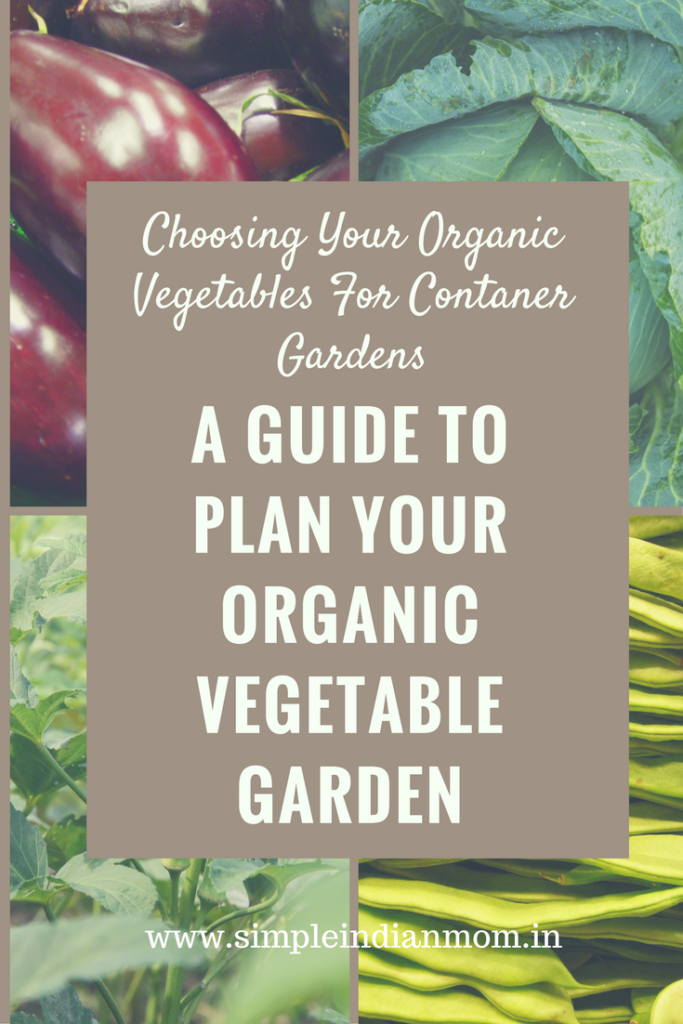Are you ready to become a super organic vegetables gardener?
Well. I think we already are covering the ground now and let us begin choosing some veggies for your organic vegetable garden.

First Things First
The first thing you need to know here is (I know many of you are going to say my granny told that, guys I really feel like a granny these day, l little overdose of traditional knowledge – Phew! okay back to track)
A few veggies can be grown all around the year. And these are the veggies we most commonly get in the market which you buy withut a second thought. They are solanaceous crops like brinjal, legumes, coriander, greens, chillies, herbs and so on.
In fact except Brinjal, other crops are quite resistant to pests and diseases. You need to know that using a piece of land or a pot to plant the same plant again and again ( even the same family ) is not advisable.
When you start a garden, you begin with first making your land fertile – we have discussed the various composts you could make from your kitchen cabinet.
So, begin by making your garden rich in the nutrients. This will then help you to choose the vegetable crops to be planted.
Prepare a chart for veggies that will be planted the whole year, this way you know what necessary steps you need to take before harvesting the earlier crop and be ready for the next one.
Points you need to remember before making the chart
- Always Use Quality Seeds
Indian Gardening Beefsteak Tomato Vegetable Seeds 40 Seeds – Rare Seeds
Quality seeds are the first requisite of a healthy vegetable garden. You would be able to get best germination, good growth and harvest. You will also be able to collect seeds for the next season.
I would seriously advice the use of native varieties, I know this is against the popular hybrid varieties, which seem to be giving great results in production, however these hybrids are hybrids, and you know how the apples taste these days, right?
It is the same for veggeis too, hybrids are hybrids!
- Try traditional varieties – They are more resistant to pest and diseases and you do not have to worry about GMO. Traditional varieties have been evolved over time in that particular area and hence would have accustomed itself to the prevailing conditions of the locality.
Also they are sturdier, consume less water and resist local pests, which is not the condition of a hybrid that is developed in some far off country in laboratory conditions.
- Use cultural practices to control pests and diseases ( I shall discuss this in detail later)
These include crop rotation, sanitation, proper row spacing, varying planting dates and seeding rate, planting on raised beds, adding to soil organic matter, using mulches, irrigating properly and many others. Most of these cultural practices are effective against more than one type of pest.
- Keeps Soil Nutrient – When you choose vegetable varieties wisely you make it possible for the soil to replenish the nutrients required by the soil to support the next crop. For example legumes are crops that enrich the soil nitrogen content. Other nutrients also get leached to soil which is helpful for other crops. Some crops act when co-cropped, which I shall be discussing here.
If you have less space try these vertical planters
Planters Vertical Garden Panels ( 3 frames + 9 pots )
How to Go About Choosing Veggies
This is easy, you need to basically know which part of the vegetable you would be using, accordingly you can plan your vegetable sowing.
- Fruiting Vegetables – these are our tomatoes, brinjal, sweet corn, cucumber, pumpkin, chillies, bhindi and so on
- Root Vegetables – Potatoes, sweet potatoes, onions, carrots, radish, beet, ginger, garlic and so on. Technically speaking many are not roots, yet this being a lay mans guide I have classed them as roots.
- Legumes – bush beans, peas, pole beans, brad beans, cluster beans and so on.
- Leafy Vegetables – This group typically includes all our greens like palak, methi, and cabbage, cauliflower, broccoli and so on.
So now that we have classified the vegetables, lets plan on how to go about choosing the right veggies and forming a pattern of for planting.
- First divide the space of your garden or the planters; you can follow a four crop pattern or a six crop pattern, which I shall be discussing in detail later in this series.
- After dividing the area/pots, identify veggies of same type and keep them together.
- Plan the crops as follows
Plan for the first crop starting may end in 4 rows/ 16 pots ( since we have already enriched the soil)
| Tomato + Pudina | Beans + Sweet Corn | Brinjal + cucumber | Bhendi + Palak |
| Tomato + Herb | Beans + Ginger | Brinjal + bottle gourd | Bhendi +corriander |
| Tomato + Pudina | Beans + Sweet Corn | Brinjal + Gourd | Bhendi + Palak |
| Tomato + herb | Beans + Ginger | Brinjal + melon | Bhendi + corriander |
You need to erect special structures for climbers which we will discuss later. You also can use other perennial plants like the Moringa (drumstick) lemons, guavas, pomegranates and fruit trees for years together harvesting intermittently.
This is a basic plan, I shall be giving the four crop and six crop plans in detail soon. Till then your home-work is to collect the seeds of the above plotted plants and be ready for the season.
Expert tip – greens and herbs can be sown right away, just take care to check on the water availability of your locality.

I am participating in #atozchallenge2017 #blogarhythm #writeaholics #writetribe #blogchatter




